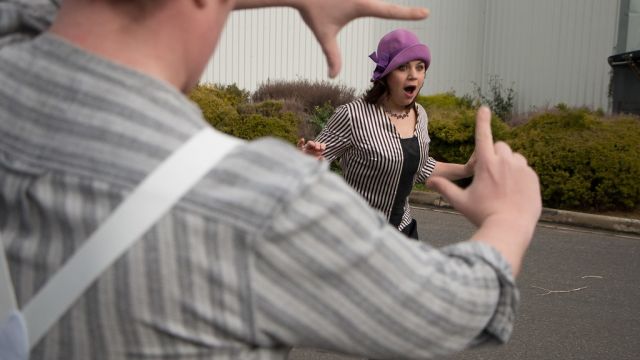Mack and Mabel
Andrew Hawkins, director of Northern Light Theatre Company’s musical Mack and Mabel, states in the program that he found the story to be “compelling and fascinating”. The audience on opening night were also immediately drawn into the era by the set and silent movies screened at the overture, promising a fun-filled ride. I too sat back prepared to be lifted along on a joyful journey through the era of silent movies, but unfortunately, whilst elements of the show are quite visually spectacular and cleverly designed, the performance lacked the vibrancy needed to ‘sell’ a show of this type.
The musical Mack and Mabel is based on the life of silent movie director Mack Sennett and his lover, comedienne Mabel Normand. The show opens with Mack (Michael Bates) reminiscing about the era of silent movies, and the time when he discovers Mabel (Jeri Williams) and her comedic potential as she tries to get her 15 cents for the sandwich she's delivered to Lottie, the actress Mack is filming at the time. Mack immediately puts her in two-reel comedies and she becomes very popular. As Mack moves his film company to California, he and Mabel fall in love. Unfortunately, their relationship is tumultuous with a core conflict over Mack’s love of comedy and Mabel’s desire to become an actress. Eventually, Mabel’s life spirals out of control.
 There are many elements of Northern Light Theatre Company’s production that deserve praise, for example set and costuming. These are standouts. The use of a mobile series of trucks adorned with movie reel is extremely clever and using them as a train and boat is inspired. The design concept overall for this show by Andrew Hawkins and John Sheehan is exceptional- use of black and white costuming, props and set are very effective.
There are many elements of Northern Light Theatre Company’s production that deserve praise, for example set and costuming. These are standouts. The use of a mobile series of trucks adorned with movie reel is extremely clever and using them as a train and boat is inspired. The design concept overall for this show by Andrew Hawkins and John Sheehan is exceptional- use of black and white costuming, props and set are very effective.
There were a few glitches on opening night with trucks not being braked properly and some scene changes in Act two were a little clunky, but as the run proceeds, this will improve. Costuming by Ann Humphries is stunning- beautifully capturing the era in black and white with the use of splashes of colour in the scene changes to California. The Beach Bathing girls’ costumes are outstanding.
The lead actors do their best to bring the show to life, but whilst Michael Bates has a beautiful voice, he needs to sell his passion more and take us on a journey that commands our attention. On opening night he was also at times not fully heard and needed to project further in dialogue. Jeri Williams is lively and convincing as Mabel. A clever actress with great talent. I did find that the pair’s relationship in the first half lacked chemistry at times.
Mention needs to be made of the hard work done by Daniel Wellman and Raymond Cullen (Fatty Arbuckle). I very much enjoyed Wellman’s slimy characterisation and stage presence. Cullen also captured the essence of the comedic genius, although his lively portrayal was at times out of sync with the sometimes flat ensemble.
The ensemble work quite hard, but overall the direction doesn’t encourage them to be energetic. For example, there are many times when the stage is silent despite large numbers of ensemble on stage. There are patches of light in some numbers - “Big Time”, “Tap your troubles away” and “Hit ‘em on the head” were high points for this reviewer. Some sharpening of freezes, more vocal projection and energy would assist in lifting the ensemble work. Some standouts in the ensemble are Chris Bussey, showing great presence and experience and two relative newcomers, Londyn Foreman and Amie Graham, who show great promise.
 Lighting and Projection design by Peter Howie and Alex Hatchard are simple and functional and the use of silent movies on film reel screens clever. Some full stage washes do not enhance these at times. The side projection board is underused; often there is just a picture of Mabel or a place and date, which are superfluous to the production. There were many technical glitches on opening night such as absent lighting, with actors speaking in darkness and mics that were either too low or reverberating.
Lighting and Projection design by Peter Howie and Alex Hatchard are simple and functional and the use of silent movies on film reel screens clever. Some full stage washes do not enhance these at times. The side projection board is underused; often there is just a picture of Mabel or a place and date, which are superfluous to the production. There were many technical glitches on opening night such as absent lighting, with actors speaking in darkness and mics that were either too low or reverberating.
The choreography by Amber Platten is very good in design – particularly the tap and Charleston routines, but the ensemble needs to complement her work with a little more pizazz!
The Orchestra led by Helen Loveday does a good job bringing the era to life, but some microphone issues with uneven levels detract from the obvious quality of the musicianship.
Overall the show is entertaining, but there are quite a few technical issues which need ironing out and the sense of hesitancy in the cast needs to be dispelled to bring the full energy of this musical to life.
Shelley Hampton
Subscribe to our E-Newsletter, buy our latest print edition or find a Performing Arts book at Book Nook.

